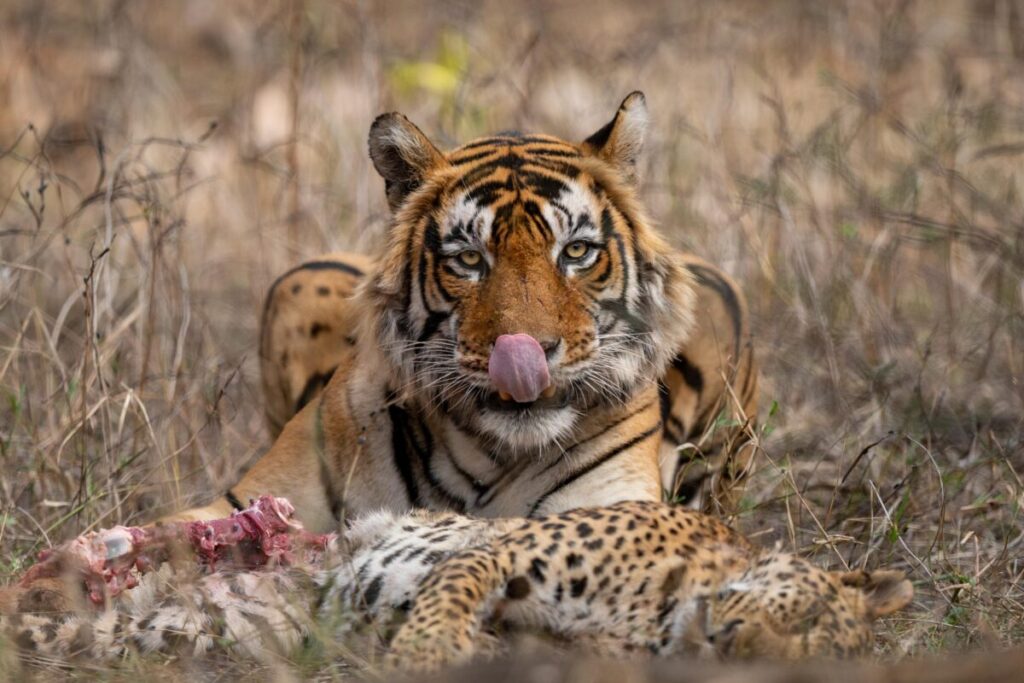How Animals Negotiate Shared Resources In The Wild
Aug 26, 2023 | Pratirodh Bureau
Tiger T101 with a leopard kill in Ranthambore National Park in Rajasthan. A study reveals that protected areas that are better maintained can support competing carnivores in high densities (Photo by Karthik Mohan Iyer)
Bengaluru-based photographers Harsha Narasimhamurthy and Karthik Mohan Iyer were following two tigers, Noor and T101, near Tutikenaale in Ranthambore in March 2023 when they had an extremely rare sighting of T101 feeding on a leopard kill. Predation between charismatic large felines in the wild is hardly a safari sight. The footage of the incident that went viral on social media displays a phenomenon that has fascinated ecologists for a long time.
Intraguild interactions are certain behaviours like competition and predation that are observed among species that share a common resource. These interactions are not only observed in carnivores like wild cats or dogs, but any species that could be competing or modifying their adaptive behaviours for a resource that is shared between them like food or habitat. These interactions influence everything from species persistence to ecosystem functioning.
What Do Intraguild Interactions Look Like?
Arjun Srivathsa of National Centre for Biological Sciences (NCBS-TIFR) who has been studying these interactions says that competition is a common intraguild interaction in the wild. It manifests in multiple forms. It could be intimidation (where one chases the other away), kleptoparasitism (where one chases the other away and makes away with the kill) or predation (where one eliminates the other). Members of one species could also opt for indirect competition (where they force the other to drop the competition) or in a bid to coexist with the competition species, the other could change its behaviour and opt for temporal partitioning (when they hunt at different times to avoid each other), spatial partitioning (look for prey in places the other is not present) or diet partitioning (change their diet to coexist with the other).
Multiple studies in the past have thrown up interesting findings of dominant species affecting the distribution and behaviour of the weaker ones. Some studies looked into how the distribution of the dominant Ural owl affected the spatial distribution of the weaker Tengmalm’s owl; how cheetahs coexist with lions by avoiding them on a moment-to-moment basis on patches of preferred habitat; or how the spatial distribution and behavioural patterns of ground beetles were impacted by red wood ants.
Plants and birds also show competitive interactions when they have to share space, food, etc. In a recent global study, scientists found that tropical montane bird species’ distributions may be more significantly shaped by competition with other birds in their guild than climate. “While we are yet to fully understand how these processes actually work, human-induced threats and climate change are further modifying these interactions,” Srivathsa told Mongabay-India.
A Study Of Three Carnivores
A new study by a team of researchers, including Srivathsa, looked into the patterns and pathways of such interactions by examining three species — dholes (Cuon alpinus), leopards (Panthera pardus) and tigers (Panthera tigris) that share habitats and preys in the protected areas across Asia.
They integrated spatial, temporal and dietary information through traditional and novel data sources. They also undertook a systematic review and meta-analysis of previous studies and developed unique data sources, along with instances of species interactions on social media and nature documentaries. “Studying carnivores in the tropical closed forest systems has been challenging due to the difficulty in direct visual observations of species interactions. Camera trapping technology has been able to address this to an extent,” said co-author Vivek Ramachandran, a faculty at NCBS-TIFR.
According to the paper, the three species were chosen on account of the decline of their co-occurrence over the past century, and because most of their source populations are confined to protected areas. The study revealed a clear social hierarchy among the species with tigers dominating, followed by dholes and then leopards. The study also found that the dholes’ pack strength helps them navigate many challenges while sharing resources with others.
Researchers also explored how dholes, despite their small size, manage to compete, coexist, and occupy the same ecological space as leopards and tigers across much of Asia’s forests. Ramachandran said that these interactions are fascinating from an evolutionary point of view, too. “A small sized meso-predator like the dhole is able to compete with much larger felids because of sociality and pack living. Behaviours are also modified to ensure survival such as adaptation to a nocturnal, diurnal or crepuscular lifestyle that avoids direct competition with co-predators,” he said.
Dholes also have a reputation that they outcompete tigers and hamper the recovery of tiger populations. Srivathsa, who has been studying dholes for a decade, hoped to counter this notion through the study. They found that when there is an adequate prey base in a protected area, the three carnivores adapt and coexist with each other, without posing a threat to one another. “Even when they have to compete, dholes are subordinate to tigers. So, tigers will fare better in cases of high competition,” he said.
The study suggests that protected areas that are better maintained, like Bandipur National Park and Wayanad Wildlife Sanctuary can support the three competing carnivores in high densities. When prey numbers are sub-optimal, like in the case of Udanti Sitanadi or Palamau Tiger Reserves, the carnivores will have to actively compete with each other and this may lead to the more subordinate species losing out, Srivathsa pointed out.
Drawing on this analysis, it is safe to say that tiger population recovery will rely less on the presence of dholes and more on ensuring adequate prey numbers and habitat health, thus emphasising on the need for better strategies for conservation.
